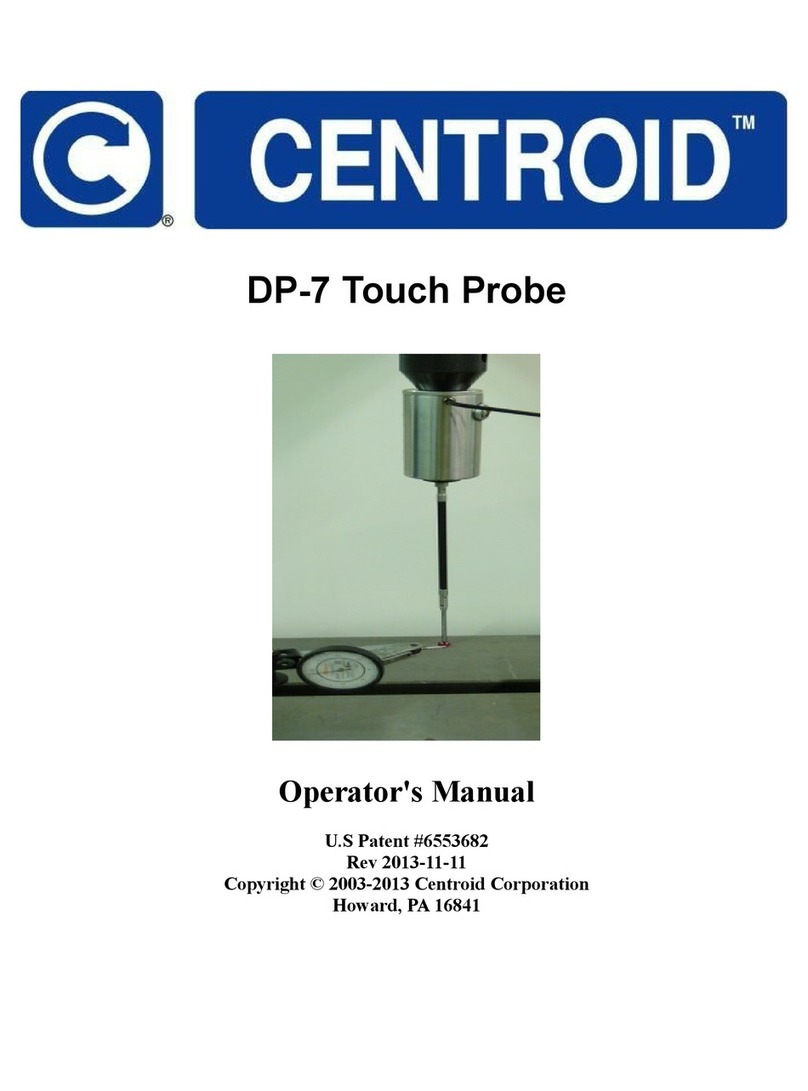
INITIAL CONTROL/PROBE SETUP PROCEDURE
STEP 1: Confirm that control parameters are setup correctly for your system. The automatic
probing cycles will not work if the parameters are not correctly set. See appendix to check the default
parameter settings for the appropriate control system. Check the control operation manual if compatible
parameter settings are not found in the appendix.
STEP 2: Plug the 6' retractile cord into the DP-4 probe and into the digitizing port on the control.
The cord ends are keyed to prevent incorrect connection. At the probe end line-up the red dot with the
red painted slot on the probe connector, push the plug in until it clicks. At the opposite cord end insert
the large black connector and rotate until it drops into the digitizing port connector then finger tighten
the securing ring to seat the connector. The LED indicating light on the front of the probe should be
illuminated bright green. Touch the probe tip and the LED should turn red.
STEP 3: Press <Alt+I> to open the centroid PLC I/O diagnostic screen. Locate the inputs entered
in parameters 11 and 18. Verify that they change correctly when the probe is triggered (parameter 11)
and plugged in (parameter 18).
STEP 4:
Review the probe overtravel limits in the specifications on page 2. Perform an automatic probe cycle
test with the feedrate over ride reduced to 20% and the stylus 10 inches away from any ob ect to verify
everything is working together. Be prepared to manually stop the machine to prevent overtravel
damage to the probe. From the main screen, press <F1-Setup>, then <F1-part>, then <F5-Probing>,
then <F7-Single Axis>, <F1-Orient> to move the probe in the desired direction and finally <Cycle
Start>. The control will og the stylus in the direction of the single axis move selected. Touch the stylus
once and the control will stop and reverse travel the probe clearance amount then stop and then resume
motion in the single axis direction at the slow probe rate. Touch the stylus once and the control will
stop and display a position window. Repeat this step and ad ust parameters as needed to gain
confidence using the automated cycles.
STYLUS TIP DIAMETER CALIBRATION:
The final procedure is to calibrate your probe stylus diameter for the tool library. Although the ruby
ball (tip) diameter of the furnished styli is either 2.5mm or 5mm, entering these values in the tool
library will not produce accurate results unless they are corrected for stylus pre-travel.
Pre-travel is the amount of deflection of the stylus tip before the probe detects the surface. This value
varies depending on the length of the stylus and the speed and direction that the stylus tip is moving
when it makes contact with the surface being probed or digitized. Pre-travel variation amount should be
stated in probe specifications relative to stylus length and direction of travel limitations. A probe that
has small pre-travel variation with no restriction on stylus length and direction of travel will be quite
expensive. Machine characteristics including lash and input latency also contribute to the need to
calibrate the stylus diameter.
In order to achieve optimal results when probing or digitizing you must calibrate the tip size to
compensate for the sum of the effects previously mentioned. The following procedure is the quickest
way to determine the calibrated diameter. This procedure uses Centroid (TM) automatic probing
cycles. Consult your operation manual for similar probing cycles for your machine.
6




























